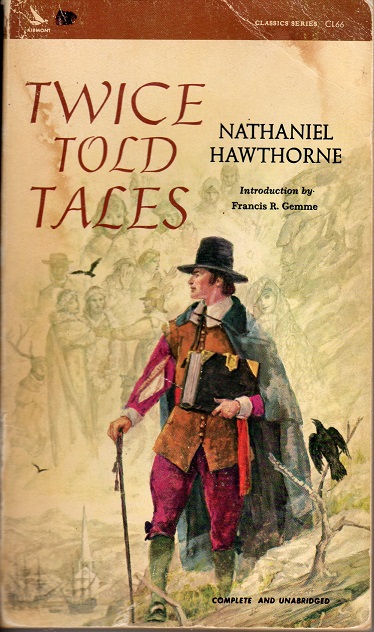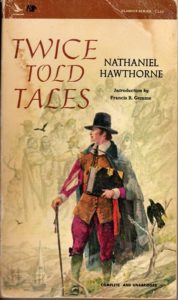Book Review: Twice Told Tales by Nathaniel Hawthorne
Nathaniel Hawthorne (1804-1864) is one of the great American writers; his The Scarlet Letter is studied in many schools across this land. But it took him quite a while to reach that status. After crushingly disappointing sales for his first novel, Fanshawe, Hawthorne spent a dozen years in poverty, scraping by selling short pieces. In 1837, his friend Horatio Bridge put up the money to have a collection of those short pieces (titled “Twice Told Tales” because they’d all been printed before) printed in a book, first anonymously, then with his name attached once good reviews came in. A second edition with more stories (39 in all) was published in December 1841, and is the one usually reprinted.
As the introduction by Professor Gemme explains, Edgar Allan Poe’s review of the later edition became famous in its own right–Poe objected to several of the pieces not actually being “tales” (what we’d call “short stories”) but essays or sketches. And in the process of explaining that, he set down his own theory of what a proper short story was. This was influential in American literary circles. Poe did praise those “tales” that met his criteria, hailing Hawthorne as one of the few worthwhile authors America had produced to that date. After that, another review seems superfluous but I will proceed.
The book opens with “The Gray Champion”, a tale of a mysterious old man who appears in 1689 to halt the massacre of malcontents in Massachusetts by the tyrannical Governor Andros. An unnamed ancient in Puritan garb, the old man is said to return whenever New England faces an existential crisis. This is only the first of many ghost-like figures in these tales, a haunted New England that influenced many American writers including H.P. Lovecraft. The first piece in the 1841 addition, “Legends of the Province House” is a collection of ghost stories involving the former colonial governor’s residence in Boston. There’s a character named Bela Tiffany, which Hawthorne admits is highly unlikely.
There are some classics in this collection, including “The Minister’s Black Veil” about a small-town minister who abruptly and for no reason he will explain conceals his face behind a cloth mask he never removes, and how that affects people’s perceptions of him. “The Great Carbuncle” concerns the search for a giant gemstone; the motives of the people looking for the jewel affect their fates, and how they react to the carbuncle’s true nature.
“David Swan” is a lesser-known piece about a young man who falls asleep by the road and is visited by Wealth, True Love and Death, awakening unaware of his brushes with fate. “Dr. Heidegger’s Experiment”, the last story in the 1837 section, involves the title character inviting some senior citizens to imbibe water from the Fountain of Youth. The story looks at the follies of both youth and age.
“Peter Goldthwaite’s Treasure” is about a man that has failed at every attempt at getting ahead in life staking everything on finding a fabled treasure of his similarly-named ancestor, even to the point of destroying the family house that is his last possession. The story makes a point of contrasting Peter, whose get rich quick schemes all rely on luck he doesn’t have, with his ex-partner John Brown who never goes for a risky prospect, but has excellent luck.
The last story in the book is “The Threefold Destiny”, which is deliberately evocative of fairy tales. A young man becomes convinced that three astounding events will occur to him, with special prophetic signs. He goes out in search of these, but his worldwide quest has none of these results. The man returns to his home village to rest before starting anew, and of course discovers his true destiny.
Mr. Hawthorne was big on allegory and symbolism, and sometimes this gets heavy-handed. Sometimes he also goes out of the way to make sure you get the point he’s trying to make, as in “The Ambitious Guest” where the moral is “you don’t know when you’re going to die, and trying to avoid fate can doom you worse than accepting it, so all human ambition is folly.”
The essays, while certainly not as compelling as the tales, are mostly good, and of interest for what they tell us about life in Hawthorne’s time. “A Rill from the Town Pump” for example examines life without central plumbing from the perspective of the main water source of the village. “The Sister Years” on the other hand is clearly a piece written for a local newspaper for New Year’s of a particular year, and has a number of in-jokes that are lost to all but scholars of that time period. (On the gripping hand, it’s not often that we see the new and old years depicted as women.)
Nathaniel Hawthorne, while very much a Christian, was not a big fan of religious fanaticism; while his Puritan ancestors took the brunt of this in his stories, he also was critical of Shakers and even Quakers on that point. The most humorous take of this is in “Endicott and the Red Cross” where the Puritan title character’s patriotic rant on the importance of “religious freedom” is interrupted by a “wanton gospeler” who reminds Endicott that he was not so keen on that freedom when he condemned the gospeler for heresy a few hours ago.
A more tragic treatment is in “The Gentle Boy” with prejudice against Quakers leading to murder and ostracism. There’s even a preacher saying that Christian mercy does not apply to the despised sect, even to their children who are no doubt permanently corrupted. (Remind you of anything?)
There’s some period sexism and racism in these stories and essays. The latter really comes up in “Mr. Higginbotham’s Catastrophe”, about a gossipy traveling salesman who hears a report that Mr. Higginbotham has been murdered, with use of the N-word in conversation. (And an equivalence of black people and the Irish as the lowest of the low.)
Overall, there’s more good material here than mediocre, and more excellence than clangers. Some of the most famous stories have been reprinted in other anthologies, or if you want to read the entire thing, there are many inexpensive reprint editions, and it is also available from Project Gutenberg.
Here’s the trailer for the 1963 Twice Told Tales movie, which is not at all faithfully adapted, but does star Vincent Price in a triple role.


